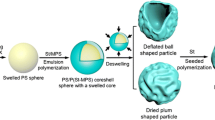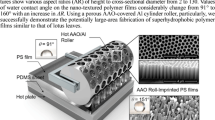Abstract
Nature always gives us inspirations to fabricate functional materials by mimicking the structure design of biomaterials. In this article, we report that polymeric aggregates with morphology similar to the papilla on lotus leaf can be self-organized in the polymer solution by adding 16 wt% water into 5 mg/ml polycarbonate solution in N, N′-dimethylformamide. The hierarchically structured aggregates at micro- and nano-scale alone show superhydrophobic effect without the need of modification with low surface energy compound. Small amount of liquid can be wrapped by the aggregates to form the so-called liquid marble. Influence of the amount of water added into the solution on the morphology of resultant polymer aggregates was investigated. By using the hierarchical aggregates as the surface building blocks, superhydrophobic coating with a static water contact angle larger than 160° and sliding angle less than 5° (for a water drop of 5 μl) was formed. Other solutions, like acid, basic and blood plasma are also repelled on the coating.







Similar content being viewed by others
References
Gu Z., Uetsuka H., Takahashi K., Nakajima R., Onishi H., Fujishima A., & Sato O. (2003). Structural color and the lotus effect. Angewandte Chemie (International Ed. in English), 42, 894–897.
Geim, A. K., Dubonos, S. V., Grigorieva, I. V., Novoselov, K. S., Zhukov, A. A., & Shapoval, S. Y. (2003). Microfabricated adhesive mimicking gecko foot-hai. Nature Materials, 2, 461–463.
Zhai, L., Berg, M. C., Cebeci, F. C., Kim, Y., Milwid, J. M., Rubner, M. F., & Cohen, R. E. (2006). Patterned superhydrophobic surfaces: Toward a synthetic mimic of the Namib Desert beetle. Nano Letters, 6, 1213–1217.
Barthlott, W., & Neinhuis, C. (1997). Purity of the sacred lotus, or escape from contamination in biological surfaces. Planta, 202, 1–8.
Feng, L., Li, S., Li, Y., Li, H., Zhang, L., Zhai, J., Song, Y., Liu, B., Jiang, L., & Zhu, D. (2002). Super-hydrophobic surfaces: From natural to artificial. Advanced Materials, 14, 1857–1860.
Wenzel, R. N. (1936). Resistance of solid surface to wetting by water. Industrial & Engineering Chemistry Research, 28, 988–994.
Cassie, A. B. D., & Baxter, S. (1944). Wettability of porous surfaces. Transitions of the Faraday Society, 40, 546–561.
Lafuma, A., & Quéré, D. (2003). Superhydrophobic states. Nature Materials, 2, 457–460.
Wier, K. A., & McCarthy, T. J. (2006). Condensation on ultrahydrophobic surfaces and its effect on droplet mobility: Ultrahydrophobic surfaces are not always water repellant. Langmuir, 22, 2433–2436.
Nakajima, A., Hashimoto, K., & Watanabe, T. (2001). Recent studies on superhydrophobic films. Monatshefte für Chemie, 132, 31–41.
Blossey, R. (2003). Self-cleaning surfaces-virtual realities. Nature Materials, 2, 301–306.
Quéré, D. (2005). Non-sticking drops. Reports on Progress in Physics, 68, 2495–2532.
Ma, M., & Hill, R. M. (2006). Superhydrophobic surfaces. Current Opinion Colloid Surface Science, 11, 193–202.
Gao, L., & McCarthy, T. J. (2006). The “lotus effect” explained: Two reasons why two length scales of topography are important. Langmuir, 22, 2966–2967.
Marmur, A. (2004). The lotus effect: Superhydrophobicity and metastability. Langmuir, 20, 3517–3519.
Patankar, N. A. (2004). Mimicking the lotus effect: Influence of double roughness structures and slender pillars. Langmuir, 20, 8209–8213.
Nosonovsky, M., & Bhushan, B. (2005). Roughness optimization for biomimetic superhydrophobic surfaces. Microsystems and Technology, 11, 535–549.
Jiang, L., Zhao, Y., & Zhai, J. (2004). A lotus-leaf-like superhydrophobic surface: A porous microshere/nanofiber composite film prepared by electrohydrodynamics. Angewandte Chemie (International Ed. in English), 43, 4338–4341.
Xie, Q., Fan, G., Zhao, N., Guo, X., Xu, J., Dong, J., Zhang, L., & Han, C. C. (2004). Facile creation of a bionic super-hydrophobic block copolymer surface. Advanced Materials, 16, 1830–1833.
Zhao, N., Xu, J., Xie, Q., Weng, L., Guo, X., Zhang, X., & Shi, L. (2005). Fabrication of biomimetic superhydrophobic coating with a micro-nano-binary structure. Macromolecular Rapid Communications, 26, 1075–1080.
Zhang, X., Shi, F., Yu, X., Liu, H., Fu, Y., Wang, Z., Jiang, L., & Li, X. (2004). Polyelectrolyte multilayer as matrix for electrochemical deposition of gold clusters: Toward super-hydrophobic surface. Journal of the American Chemical Society, 126, 3064–3065.
Furstner, R., Barthlott, W., Neinhuis, C., & Walzel, P. (2005). Wetting and self-cleaning properties of artificial superhydrophobic surfaces. Langmuir, 21, 956–961.
Zhao, N., Weng, L., Zhang, X., Xie, Q., Zhang, X., & Xu, J. (2006). A lotus-leaf-like superhydrophobic surface prepared by solvent-induced crystallization. Chemphyschem: A European Journal of Chemical Physics and Physical chemistry, 7, 824–827.
Heiss, H. L. (1979). The classification of solvents for bis-phenol-A polycarbonate. Polymer and Engineering Science, 19, 625–637.
Schorn, H., Kosfeld, R., & Hess, M. (1986). Investigation of the solution crystallization behaviour of polycarbonate. Journal of Chromatography. A, 353, 273–277.
Aussillous, P., & Quéré, D. (2001). Liquid marbles. Nature, 411, 924–927.
Yan, H., Shiga, H., Ito, E., Nakagaki, T., Takagi, S., Ueda, T., & Tsujii, K. (2006). Super water-repellent surfaces with fractal structures and their potential application to biological studies. Colloids and Surfaces. A, Physicochemical and Engineering Aspects, 284–285, 490–494.
Busscher, H. J., Stokroos, I., Golverdingen, J. G., & Schakenraad, J. M. (1991). Adhesion and spreading of human fibroblasts on superhydrophobic FET-Teflon. Cells and Materials, 1, 243–249.
Sun, T. L., Tan, H., Han, D., Fu, Q., & Jiang, L. (2005). No platelet can adhere–Largely improved blood compatibility on nanostructured superhydrophobic surfaces. Small, 1, 959–963.
Khorasani, M. T., & Mirzadeh, H. (2004). In vitro blood compatibility of modified PDMS surfaces as superhydrophobic and superhydrophilic materials. Journal of Applied Polymer Science, 91, 2042–2047.
Genzer, J., & Efimenko, K. (2006). Recent developments in superhydrophobic surfaces and their relevance to marine fouling: A review. Biofouling, 22, 339–360.
Acknowledgements
This work was supported by the National Natural Science Foundation of China (NO. 50521302 and No. 50425312) and Innovation Project of CAS. We acknowledged Prof. Charles C. Han for the fruitful discussion.
Author information
Authors and Affiliations
Corresponding author
Rights and permissions
About this article
Cite this article
Zhao, N., Zhang, XY., Li, YF. et al. Self-organized Polymer Aggregates with a Biomimetic Hierarchical Structure and its Superhydrophobic Effect. Cell Biochem Biophys 49, 91–97 (2007). https://doi.org/10.1007/s12013-007-0044-3
Accepted:
Published:
Issue Date:
DOI: https://doi.org/10.1007/s12013-007-0044-3




